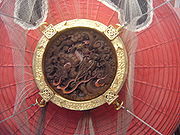
Kaminarimon
Encyclopedia
,_sensoji_temple,_akakusa,_tokyo.jpg)
Senso-ji
is an ancient Buddhist temple located in Asakusa, Taitō, Tokyo. It is Tokyo's oldest temple, and one of its most significant. Formerly associated with the Tendai sect, it became independent after World War II. Adjacent to the temple is a Shinto shrine, the Asakusa Shrine.- History :The temple is...
(the inner being the Hōzōmon
Hozomon
The is the inner of two large entrance gates that ultimately leads to the Sensō-ji in Asakusa, Tokyo. A two-story gate , the Hōzōmon's second story houses many of the Sensō-ji's treasures. The first story houses two statues, three lanterns and two large sandals...
) in Asakusa
Asakusa
is a district in Taitō, Tokyo, Japan, most famous for the Sensō-ji, a Buddhist temple dedicated to the bodhisattva Kannon. There are several other temples in Asakusa, as well as various festivals.- History :...
, Tokyo, Japan. The gate, with its lantern and statues, is popular with tourists. It stands 11.7 m tall, 11.4 m wide and covers and area of 69.3 m2.
History
The Kaminarimon was first built in 942 by TairaTaira clan
The was a major Japanese clan of samurai in historical Japan.In reference to Japanese history, along with Minamoto, Taira was a hereditary clan name bestowed by the emperors of the Heian Period to certain ex-members of the imperial family when they became subjects...
no Kinmasa. It was originally located near Komagata, but it was reconstructed in its current location in 1635. This is believed to be when the statues of Raijin and Fūjin were first placed on the gate. The gate has been destroyed many times throughout the ages. Four years after its relocation, the Kaminarimon burned down, and in 1649 Tokugawa Iemitsu
Tokugawa Iemitsu
Tokugawa Iemitsu was the third shogun of the Tokugawa dynasty. He was the eldest son of Tokugawa Hidetada, and the grandson of Tokugawa Ieyasu. Iemitsu ruled from 1623 to 1651.-Early life :...
rebuilt the gate along with several other of the major structures in the temple complex. The Kaminarimon's current structure dates from 1960.
Features

Shinto
or Shintoism, also kami-no-michi, is the indigenous spirituality of Japan and the Japanese people. It is a set of practices, to be carried out diligently, to establish a connection between present day Japan and its ancient past. Shinto practices were first recorded and codified in the written...
gods Fūjin
Fujin
is the Japanese god of the wind and one of the eldest Shinto gods.He is portrayed as a terrifying dark demon, resembling a red headed black humanoid wearing a leopard skin, carrying a large bag of winds on his shoulders....
and Raijin
Raijin
is a god of lightning, thunder and storms in the Shinto religion and in Japanese mythology.His name is derived from the Japanese words rai and shin . He is typically depicted as a demon beating drums to create thunder, usually with the symbol tomoe drawn on the drums...
are displayed. Fūjin, literally the god of wind, is located on the east side of the gate, while Raijin, literally the god of thunder, is located on the west side. Two additional statues stand on the reverse of the gate: the Buddhist
Buddhism
Buddhism is a religion and philosophy encompassing a variety of traditions, beliefs and practices, largely based on teachings attributed to Siddhartha Gautama, commonly known as the Buddha . The Buddha lived and taught in the northeastern Indian subcontinent some time between the 6th and 4th...
god Tenryū on the east, and the goddess Kinryū on the west side.
In the center of the Kaminarimon, under the gate, hangs a giant red chōchin that is 4 meters tall, 3.4 meters in circumference and weighs 670 kilograms (1,477.1 lb). Being very fragile, the lantern is not an original piece. It is instead a restoration that was donated in August 2003 in commemoration of the 400th anniversary of the start of the Edo period
Edo period
The , or , is a division of Japanese history which was ruled by the shoguns of the Tokugawa family, running from 1603 to 1868. The political entity of this period was the Tokugawa shogunate....
by Konosuke Matsushita
Konosuke Matsushita
was a Japanese industrialist, the founder of Panasonic, a company based in the suburb of Kadoma , Osaka in Japan. For many Japanese, he is known as "the god of management"...
, the founder of the Matsushita Electric Industrial Co. (now known as Panasonic
Panasonic
Panasonic is an international brand name for Japanese electric products manufacturer Panasonic Corporation, which was formerly known as Matsushita Electric Industrial Co., Ltd...
).
The front of the lantern displays the gate's name, . Painted on the back is the gate’s official name, . A wooden carving depicting a dragon adorns the bottom of the lantern.
During festivals such as Sanja Matsuri
Sanja Matsuri
, or Sanja Festival, is one of the three great Shinto festivals in Tokyo, along with the Kanda Matsuri and Sannō Matsuri. It is considered one of the wildest and largest. The festival is held in honor of Hinokuma Hamanari, Hinokuma Takenari and Hajino Nakatomo, the three men who established and...
, the lantern is collapsed to let tall objects pass through the gate.
The characters on the tablet above the lantern read from right to left and reference the Sensō-ji.

